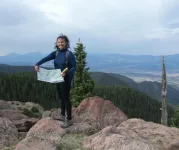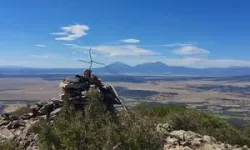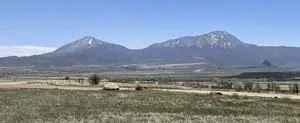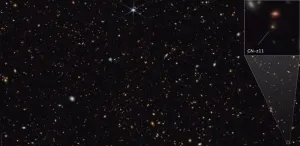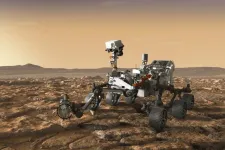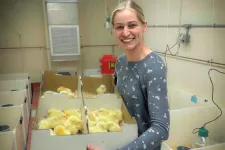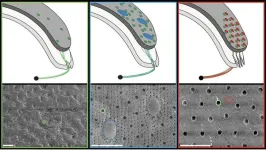(Press-News.org) If you’ve driven the mostly flat stretch of I-25 in Colorado from Pueblo to Trinidad, you’ve seen them: the Spanish Peaks, twin mountains that soar into the sky out of nowhere, reaching altitudes of 13,628 and 12,701 feet above sea level.
In a new study, geologists from the University of Colorado Boulder have laid out a timeline for the emergence of these majestic but isolated mountains. The team’s findings could bring scientists closer to answering one of the most enduring puzzles in Colorado geology: What made Denver, the Mile High City, a mile high?
“For geologists, the big question is: Why are Colorado’s High Plains so high?” said Sabrina Kainz, who led the research as an undergraduate student studying geology at CU Boulder.
The group published its findings March 1 in the scientific journal “Lithosphere.”
Colorado’s craggy, snow-capped Rocky Mountains attract tourists and more. But for researchers like Kainz and CU Boulder geologist Lon Abbott, the High Plains that extend over much of eastern Colorado—the territory of tumbleweeds and prairie dogs—may be even more interesting.
Abbott explained that the world’s highest places tend to be that way because of squishing and squeezing from tectonic plates—giant pieces of Earth’s crust that slam together, crumpling up land masses and raising entire mountain ranges. But Colorado’s High Plains, which are dominated by sedimentary rocks, aren’t crumpled at all. They’re one tall, flat stack of geological pancakes.
“The Colorado High Plains are anomalous, really, in the entire world,” said Abbott, co-author of the study and teaching professor in the Department of Geological Sciences. “They’re not formed the way that mountains are typically formed.”
To get nearer to solving the mystery of the plains, the researchers collected and analyzed rocks from the Spanish Peaks east to Two Buttes, a geologic formation near the Kansas border.
They found that the rocks forming the Spanish Peaks injected into the crust below Colorado as magma around 24 million years ago, but remained miles underground until about 17 million years ago. What happened to bring them to the surface remains a mystery.
“We can answer when the plains around the Spanish Peaks got so high,” Kainz said. “The ‘why’ of the matter is a little more complicated.”
Colorado landmark
The Spanish Peaks have long been an important monument for generations of people who have called southern Colorado home.
The indigenous Comanche people referred to these formations as “Wahatoya,” which means “Double Mountain.” In the early 1800s, travelers following the Santa Fe Trail, which joined Missouri to what is now the southwestern U.S., formerly the northern reaches of New Spain and then Mexico, used the peaks as a landmark.
“They would spend weeks and weeks traveling in their wagons on the plains,” said Abbott, whose book “Geology Underfoot Along Colorado’s Front Range” is a primer for the state’s rockhounds. “Then, all of a sudden, they'd see those mountains, and they knew they were getting close.”
In 1913, hundreds of coal miners striking against the Colorado Fuel and Iron Company set up a tent camp not far from the mountains—a prelude to the Ludlow Massacre of 1914, which remains among the nation’s deadliest labor disputes.
The peaks have always been a bit mysterious. They are as tall as many of the Rocky Mountain summits to the west, but the Spanish Peaks formed at a different time and from completely different rocks.
For Kainz, now a doctoral student at the University of Washington in Seattle, getting to study those features as an undergrad was a dream come true. She began the project at the height of the COVID pandemic in 2020, and spent hours crammed into cars with dozens of rock samples.
The team included Rebecca Flowers, professor of geological sciences; undergraduate geology student Skye Fernandez; James Metcalf, manager of the Thermochronology Research and Instrumentation Laboratory (TRaIL); and Aidan Olsson, then a student at Fairview High School in Boulder now studying biology at CU Boulder.
The project hinged on an approach called thermochronology. Kainz noted that small chemical changes in the crystals within many rocks can give geologists clues about how hot or cold those samples were millions of years ago. Rocks buried deep below the Earth tend to be hotter than those closer to the surface.
More than a mile high
According to the team’s results, the Spanish Peaks first formed when magma welled up from deep within Earth’s crust but didn’t quite break through to the surface.
Then, something happened. In a very short span of time, geologically-speaking, huge tracks of land in southeastern Colorado vanished. Between roughly 18 and 14 million years ago, more than a mile of sedimentary rocks around the Spanish Peaks eroded away, then were swept into the Arkansas River.
The researchers suspect that as-of-yet-unidentified geologic forces were pushing up southeastern Colorado from below—exposing previously underground rocks to rain and flowing water.
Abbott and his colleagues are now exploring how this disturbance may have fit into the broader evolution of Colorado’s plains. Their preliminary data, for example, suggests that the flat lands around what is now Denver may not have experienced similar upheaval at the same time.
But the study makes one thing clear: Colorado’s High Plains have long been something to behold.
“As high as the High Plains are today, they used to be a lot higher,” Kainz said. “They were as high as the Rocky Mountains are today.”
END
Geologists explore the hidden history of Colorado’s Spanish Peaks
2024-03-04
ELSE PRESS RELEASES FROM THIS DATE:
Webb unlocks secrets of one of the most distant galaxies ever seen
2024-03-04
Looking deeply into space and time, two teams using NASA’s James Webb Space Telescope have studied the exceptionally luminous galaxy GN-z11, which existed when our 13.8 billion-year-old universe was only about 430 million years old.
Initially detected with NASA’s Hubble Space Telescope, this galaxy — one of the youngest and most distant ever observed — is so bright that it is challenging scientists to understand why. Now, GN-z11 is giving up some of its secrets.
Vigorous Black Hole Is Most Distant Ever Found
A team studying ...
3D-printed skin closes wounds and contains hair follicle precursors
2024-03-04
UNIVERSITY PARK, Pa. — Fat tissue holds the key to 3D printing layered living skin and potentially hair follicles, according to researchers who recently harnessed fat cells and supporting structures from clinically procured human tissue to precisely correct injuries in rats. The advancement could have implications for reconstructive facial surgery and even hair growth treatments for humans.
The team’s findings published today (March 1) in Bioactive Materials. The U.S. Patent and Trademark ...
Discovered a RNA molecule that helps prevent DNA replication errors
2024-03-04
Researchers at Cima Universidad de Navarra have discovered that a ribonucleic acid that does not contain information to make proteins (long non-coding RNA) plays a crucial role in signalling and repairing errors in DNA replication during cell division. This finding could lead to the development of new anti-tumour therapies.
Scientists have identified an RNA that they named 'lncREST' (long non-coding RNA REplication STress) and uncovered its role in triggering an effective response to the stress induced by rapid cell division. "LncREST localises ...
Small and overlooked: Amount of repetitive DNA in blood hints at cancer early
2024-03-04
FOR IMMEDIATE RELEASE
People with cancer have different amounts of a type of repetitive DNA — called Alu elements — than people without cancer. Now, machine learning can measure that from a blood draw. Researchers at the Johns Hopkins Kimmel Cancer Center have used this finding to improve a test that detects cancer early, validating and reproducing the results by starting with a sample size tenfold larger than typical of such types of studies.
The research was published Jan. 24 in the journal Science Translational Medicine.
Alu ...
Study determines the original orientations of rocks drilled on Mars
2024-03-04
As it trundles around an ancient lakebed on Mars, NASA’s Perseverance rover is assembling a one-of-a-kind rock collection. The car-sized explorer is methodically drilling into the Red Planet’s surface and pulling out cores of bedrock that it’s storing in sturdy titanium tubes. Scientists hope to one day return the tubes to Earth and analyze their contents for traces of embedded microbial life.
Since it touched down on the surface of Mars in 2021, the rover has filled 20 of its 43 tubes with cores of bedrock. Now, MIT geologists have remotely determined a crucial property of the rocks collected to date, which will help scientists answer key questions about the planet’s ...
Illinois study: Supporting disease-challenged broiler chickens through nutrition
2024-03-04
URBANA, Ill. — When broiler chickens are busy fighting the parasitic infection coccidiosis, they can’t absorb nutrients efficiently or put energy toward growth. With consumer sentiment pitted against antimicrobials and other drugs, producers still have some options to ensure optimal growth during inevitable outbreaks. New research from the University of Illinois Urbana-Champaign suggests diet changes might help.
“Vaccines and anticoccidials are the traditional ways to prevent this disease. Nutrition can't replace all of the pharmaceuticals, but it can be supportive in providing care,” said senior study author Ryan Dilger, ...
Communities severed by roads and traffic experience a larger number of collisions in New York City
2024-03-04
March 4, 2024- New York City neighborhoods with disrupted community connections, due to traffic, roads, and transport infrastructure, are experiencing an increase in traffic collisions. This increase is seen both in total collisions and for those in which pedestrians or cyclists are injured or killed, according to a new study from Columbia University Mailman School of Public Health. The findings are reported in the journal Environment International.
“Despite recent remarkable progress, road safety remains an urgent urban issue in New York and other U.S. cities. It is important to understand how the spatial configuration of the city enhances ...
Study shows new class of antivirals that works against SARS-CoV-2
2024-03-04
EDMONTON — A University of Alberta research team has uncovered a new class of drugs with the potential to prevent or treat infections in a future viral outbreak.
In the paper, published this week in Nature, the team reports that SARS-CoV-2 — the virus that causes COVID-19 — activates a pathway in cells that stops the production of peroxisomes and interferon, key parts of the normal immune response. The team successfully tested a new class of antiviral drugs that stimulate interferon production to reverse that effect.
Tom ...
Cost of direct air carbon capture to remain higher than hoped
2024-03-04
Switzerland plans to reduce its net carbon emissions to zero by no later than 2050. To achieve this, it will need to drastically reduce its greenhouse gas emissions. In its climate strategy, the Swiss government acknowledges that some of these emissions, particularly in agriculture and industry, are difficult or impossible to avoid. Swiss climate policy therefore envisages actively removing 5 million tonnes of CO2 from the air and permanently storing it underground. By way of comparison, the Intergovernmental ...
Unraveling the mystery of chiton visual systems
2024-03-04
(Santa Barbara, Calif.) — You’d probably walk past a chiton without even seeing it. These creatures often look like nothing more than another speck of seaweed on the crusty intertidal rocks. But it sees you. At least, if it’s one of the species with eyes dotting its platemail shell.
A team of scientists — led by Rebecca Varney at UC Santa Barbara’s Department of Ecology, Evolution, and Marine Biology (EEMB) — discovered that some of these tough mollusks sport the most recently evolved eyes with a lens. What’s more, the ...
